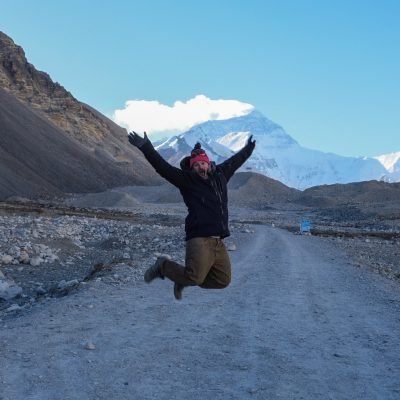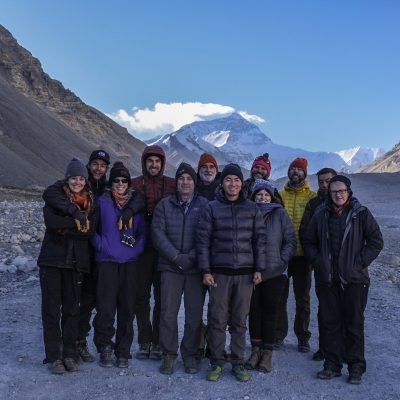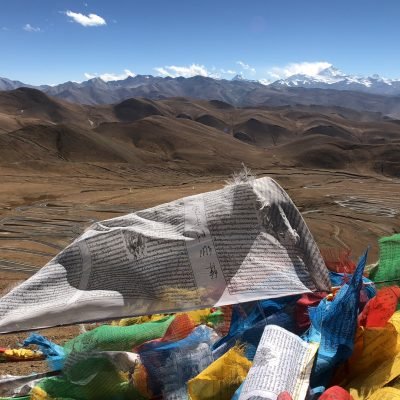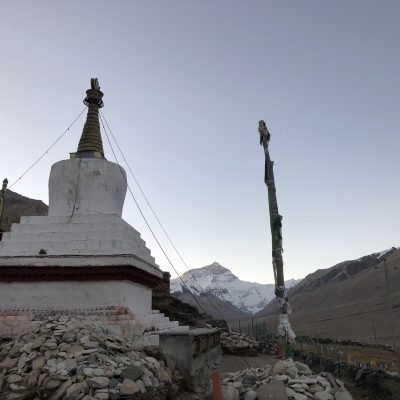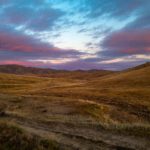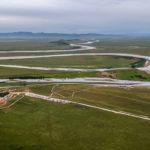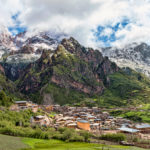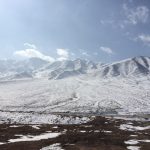As the world’s highest mountain, Everest has become an icon of both fame and mysticism.
But where exactly is this place and what does it really take to travel there?
Find out what it is like to travel to the Tibet side of Everest Base Camp in this travel blog.
Introduction to Everest Base Camp, Tibet
Everest base camp refers generally to two base camps on opposite sides of Mount Everest: South Base Camp is in Nepal at an altitude of 5,364 metres (17,598 ft) (28°0′26″N 86°51′34″E), while North Base Camp is in Tibet, China at 5,150 metres (16,900 ft) (28°8′29″N 86°51′5″E).
The base camps are rudimentary campsites on Mount Everest that are used by mountain climbers during their ascent and descent; they are also visited by tourists. South Base Camp is used when climbing via the southeast ridge, while North Base Camp is used when climbing via the northeast ridge.
Supplies are shipped to the South Base Camp by porters (Kulli), and with the help of animals, usually yaks. The North Base Camp is accessed by a paved road that branches from China National Highway 318. Climbers typically rest at base camp for several days for acclimatization, to reduce the risks and severity of altitude sickness.
Now I know the reality: there are many “Everest Base Camps” for the real mountaineers and they make their way slowly up the mountain, acclimatizing at various base camps along the way. The EBC that visitors go to is simply that: a visitor’s EBC. You can see the high-tech gear of the real trekkers from afar but you’re not allowed to mingle. That said, you still reach an altitude of 5,200m (~17,000feet), so it’s nothing to be ashamed of on that end. Additionally, you have incredible views of Everest, even from the rocks behind which you relieve yourself in the morning. I’ve never had a more amazing view from my “bathroom” window.
A visit to the North Base Camp currently requires a permit from the Chinese government, on top of the permit required to visit Tibet itself. Such permits must be arranged via travel companies in Lhasa as part of a package tour that include hiring a vehicle, driver, and guide. The North Base Camp is accessed by vehicle through a 100 km road branching to the South from the Friendship Highway near Shelkar. From the Base Camp, all tourists must take the buses managed by the government to limit the traffic in the last stretch of gravel road to a marked hill at 5,200 meters above sea level just before the climbers’ camp. It is also possible to trek up from the tourist camp, but only when properly acclimatized. The “tourist Base Camp” is located about halfway between Rongbuk Monastery; the actual climbers’ Base Camp is at the foot of Rongbuk glacier.
Getting to Mount Everest Base Camp
There’s no other way to say it: we had a hell of a drive. Depending on conditions and what kind of vehicle you’re in, it can take anywhere from 8 to 12 hours to get to EBC from Shigatse.
The “good” road was under construction so we had to take a longer way and after a checkpoint, the pavement ended and we descended onto a gravel path. At some point, the gravel gave way to dirt and as we bounced along the bus became stuck. We piled off and watched as our driver and guide piled rocks under the back wheels and eventually, the bus got out. (We were instructed to walk beside the bus until it got onto safer, less bumpy, less muddy, ground.)
So it’s an adventure. But if you’re a small group in a 4-wheel-drive, it won’t take you so long. But I’d still advise you to be prepared to add a few hours onto whatever the time on your itinerary says.
Arriving at Everest Base Camp (EBC)
You’ll pass through a small village where there’s a monastery called Rongbuk. The monastery has a small guesthouse that accommodates travelers but we were told it is better (cleaner, more comfortable) to stay in the tent encampment if possible.
Read a review of Staying at EBC Tent Village.
We arrived just as the sun was setting but we did manage to see a dusk view of Everest and the exhilaration of seeing the mountain made the drive worth it. We piled our things into the tent as the light faded and tried to get comfortable as the wind whipped around the tent, dogs howled and a few of us succumbed to altitude sickness.
Trekking to Everest Base Camp
The idea is that you walk the 2 hours from the ten village to the highest point where there is a scenic view of Everest (and the mountaineers’ base camp, incidentally). If you don’t want to make the trek, a tourist bus can drive you from the tent village to the scenic point in about 15 minutes.
Those of us feeling fit enough to do it got up before the sunrise to start the trek. At over 5,200m (~17,000feet) the going is slow but the views are stunning. The trek leads you from the tent village up a gradual rocky pathway that gets slightly steeper as you go. After ascending the hill (with amazing views of Everest already), you get sight of the scenic spot and all the other visitors. You descend from this hill to meet up with the road and then ascend another small hill that is covered with prayer flags – the scenic viewpoint.
Base Camp (5,200 meters)
It’s difficult not to feel completely elated at the sight of Everest, the thousands of prayer flags at the scenic point and fellow visitors making their way to the top. You really feel like celebrating and there’s a real sense of camaraderie – handing around cameras to take photos in front of the best view in the world.
We hung a set of prayer flags at the top of the lookout, posed for a hundred photos and then sadly, turned our backs to Mt. Everest. Of our group of ten, only six of us made it on the morning trek and while it would have been nice to sit in the sun and look at Everest all day, we needed to get back to check on our friends and to start the long drive back to Shigatse.
One note, while there’s no outward show of authority, in other words, you don’t see armed guards marching around like you do at the Barkor, our guide warned us not to try to hang any national flags at the scenic point.
Leaving Base Camp
We managed to get a lift back to the tents from one of the tourist buses and were thankful not to have to walk the two hours back. After arriving back, we had a quick breakfast, packed up and loaded everything back on the bus. We were on our long way back to Shigatse by about 10am.
The visit seemed too short. It took us so long to get to Everest, the literal and figurative highpoint of our journey, and now we were already on our way back. I had to sit backwards in the bus for a while to let the view linger.
History of the First Ascent of Mount Everest
Everest was first climbed by Tenzin Norgay and Sir Edmund Hillary in May 1953. Tenzin was a Nepalese Sherpa and the Hillary was a beekeeper from New Zealand, but the entire expedition was largely British run and organized.
As the Brits were the first to survey Everest, fly over Everest in an airplane, and for, many years to scout out its base, it was a matter of national pride for the British to “beat” the Swiss and the Russians to be the first westerners to summit the mountain.
Those responsible for planning and funding the successful 1953 British Everest Expedition were in no doubt that national pride was at stake. The British had enjoyed almost exclusive access to Everest through Tibet, granted (and sometimes strategically withheld) for the expeditions of the 1920s and 1930s. It came as something of a shock when the Nepali government decided to offer the Swiss not one, but two attempts on the mountain in 1952 – this made it absolutely clear to the Himalayan Committee (a joint committee of the Royal Geographical Society and Alpine Club) that the stakes had been raised. An attempt in 1953 might be the last chance for a British team to be the first to the top, with French, Russian and American climbers also hoping for a shot at the mountain.
Organizers and mountaineers argued that economic benefits would come from this sort of national success. In 1952 the Himalayan Committee sent a training expedition to nearby mountain Cho Oyu, to try out team members and equipment. This team sent back a report stating very clearly the monetary value of a successful climb of Everest:
The difference between a successful British attempt on Everest and a Continental or Russian ascent should be worth several millions to the British government as a very considerable and badly needed fillip to national prestige. This should be convertible to cash.
Earlier, the Himalayan Committee had tried to get British climbers onto the Swiss expedition – joint prestige was better than no prestige! – but the scheme fell apart. When the plans for 1953 were drawn up the Himalayan Committee refused permission for American and European climbers to join the team, on the grounds that it should be thoroughly British in composition (or, at least, British and Commonwealth). With many organizations busy with rearmament after World War II, and some rationing still in place, the argument about ‘national prestige’ and a thoroughly ‘British’ expedition was used to get hold of crucial respiratory technology and foodstuffs.
Despite the rhetoric, a fair part of the expedition was not British at all. Aside from the obvious point about climbers from New Zealand, the entire expedition would have been impossible without the support and experience of hundreds of porters and dozens of high altitude Sherpas. Less obvious, perhaps, is the amount of foreign technology and ‘know how’ used.
Several members of the expedition, including the physiologist Griff Pugh, went to Switzerland to talk to scientists and mountaineers about Everest. Much of the specialist equipment couldn’t be sourced in Britain, and instead Alpine nations – Switzerland, Germany, France – supplied gloves, snow shovels, tents, and so on. Military barometric chamber and aviation experiments by American mountaineering scientist Charles Houston were important to Griff Pugh’s careful techno-medical preparation. Even the food and oxygen left on the mountainside by the Swiss team were factored into the plan for the British expedition.
This sort of internationalism doesn’t always work out. The first specifically International Everest expedition, in 1971, found that Austrian crampons wouldn’t fit on German boots, and more importantly that the American oxygen masks would not fit the Sherpas. (The Americans had two styles of mask, the ‘Caucasian’, and the ‘Oriental’ which was based on Vietnamese physiognomy and was completely inappropriate for the Sherpas).
1953 was still, in lots of meaningful ways, a British success: nearly all the team members and organizers and funders were British, as was the majority of the food and equipment, and definitely the final, conclusive research by Griff Pugh. But the know-how was international. When it comes to funding science (including scientific expeditions), this can lead to dilemmas. How do we claim prestige in this mixed-up international space? How do we measure the success of national funding when ideas in one country may lead to technologies or successful expeditions or new ideas in another country? Can an invention or discovery be called ‘British’ if 80% of the science behind it was conducted elsewhere, or if half the components were made overseas? Or is it enough for the person who takes the final step – in science or on a mountain – to have a British passport?
